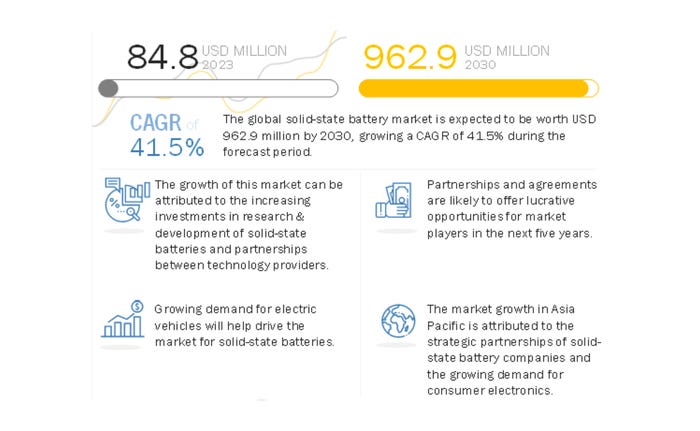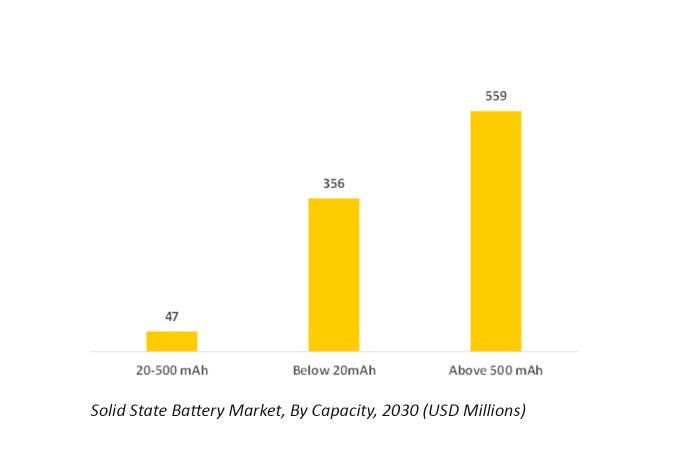Solid State Batteries: The Future of Energy Storage?
Analysts from MarketsandMarkets examine the scope and future value of the emerging SSB market.

Solid-state batteries (SSBs) use solid electrolytes in place of gel or liquid-based electrolytes. They are based on the concept of using solid material in all the components of batteries. These batteries overcome the disadvantage of conventional batteries since they have a long shelf life, are safe to use, and offer high energy. This solid electrolyte in these batteries results in their compact packaging and lightweight. These features make solid-state batteries ideal for use in a number of advanced applications and demand next-generation power sources such as electric vehicles and IoT devices.

Image courtesy of MarketsandMarkets
Solid-state batteries have a wide range of potential applications, and the list of possible uses is not exhaustive. As solid-state battery technology continues to develop, it can find applications across various industries. These applications are as follows:
Electric vehicles: SSBs could be used in electric vehicles to provide a longer range and faster charging times.
Grid-scale energy storage: SSBs could be used to store energy from renewable energy sources, such as solar and wind power.
Portable electronics: SSBs could be used in portable electronics like smartphones and laptops to provide longer battery life.
The Solid-State battery is poised to rival numerous batteries in the market, the most prominent being the lithium-ion battery. Solid-state batteries present several advantages over their lithium-ion counterparts, such as:
Higher energy density: SSBs can store more energy than lithium-ion batteries of the same size and weight. This means that electric vehicles with SSBs could have longer ranges.
Faster charging: SSBs can charge faster than lithium-ion batteries. This is because the solid electrolyte has a lower resistance than the liquid electrolyte.
Improved safety: SSBs are safer than lithium-ion batteries because they are less likely to catch fire or explode. This is because the solid electrolyte cannot leak and come into contact with the electrodes.
Longer lifespan: SSBs have a longer lifespan than lithium-ion batteries. This is because the solid electrolyte is less likely to degrade over time.
Here is a concise explanation of how changes in revenue sources can affect the battery ecosystem with various chemistry types.

Image courtesy of MarketsandMarkets
Commercialization of SSBs
Solid-state batteries have not yet reached complete commercialization. Several challenges must be addressed before solid-state batteries can be produced on a large scale, and one of these challenges pertains to manufacturing.
Developing solid-state batteries demands substantial investments in conducting research and development and establishing manufacturing facilities. Typically, solid-state batteries come at a higher cost compared to traditional batteries. The cost of materials utilized in their development plays a crucial role in their selection. Obtaining cost-effective, highly efficient electrodes poses challenges for battery manufacturers. Designing a stable and chemically sound solid electrolyte is also a complex task. Manufacturers might need a dedicated production line for solid-state batteries due to the differing technology involved compared to conventional batteries.
Nonetheless, as technology advances in the future, we can anticipate significant advancements in solid-state battery technology. In fact, numerous companies are actively engaged in the development of solid-state batteries, with some currently in the research and development phase while others are on the verge of commercializing these technologies within the next 2-5 years.
Pricing of SSBs
Given that solid-state batteries are still in development or on the cusp of commercialization, their pricing holds significant importance. Ideally, solid-state battery pricing should be competitive with, or at least comparable to, lithium-ion batteries. However, the high cost associated with electrolyte materials, electrolyte development, and intricate manufacturing processes present challenges in achieving lower prices.
Many companies generate revenue by selling sample prototypes of their solid-state batteries to end users. Additionally, these companies earn service revenue by providing battery prototype technology to automotive, medical, and consumer electronics manufacturers for future research and testing purposes. As the market is in its early stages with limited commercialization, it is currently unfeasible to determine the average price of these batteries across various applications.
According to estimates, the price of lithium-ion batteries stood at approximately USD 151 per kilowatt-hour in 2022 and is projected to decline further, reaching around USD 100 per kilowatt-hour by 2026. In an ideal scenario, the price of solid-state batteries should also align with this target of approximately USD 100 per kilowatt-hour, facilitating their widespread adoption across various applications without significant cost-related challenges. However, it's essential to consider that these prices may fluctuate in the future due to market conditions, such as inflation and material costs, potentially establishing new price benchmarks for battery technology.
Market estimation of SSBs
To gain insights into the solid-state battery market, we have divided it into two primary segments: one based on capacity and the other based on application. In terms of capacity, the segmentation includes three categories: 20 mAh, 20 to 500 mAh, and above 500 mAh. Meanwhile, the application segment is further categorized into consumer electronics, packaging, medical devices, energy harvesting, wireless sensors, electric vehicles, and various other applications.
Solid State Battery Market, By Capacity, 2030 (USD Millions)

Image courtesy of MarketsandMarkets
Solid-state batteries boasting a capacity exceeding 500 mAh are specifically engineered for products and devices demanding higher energy levels and extended battery lifespans, such as electric vehicles and energy harvesting systems. Furthermore, batteries with capacities surpassing 500 mAh are anticipated to experience a robust CAGR exceeding 52% from 2023 to 2030.
Solid State Battery Market, by Application, 2030 (USD Millions)

Image courtesy of MarketsandMarkets
The electric vehicle sector is poised to emerge as a significant proponent of solid-state batteries, primarily due to the advantages they offer compared to traditional lithium-ion batteries, including heightened energy density and enhanced safety features. Forecasts indicate that the market for electric vehicles is projected to witness remarkable growth, with a substantial CAGR exceeding 51% expected from 2023 to 2030, ultimately reaching a value of USD 364.3 million by 2030.
Innovative companies working on SSBs
Several companies are actively engaged in the advancement of solid-state battery technology, and a select few noteworthy ones have been briefly outlined, along with their recent endeavors in the field of solid-state battery technology.
SK On Co., a South Korean battery maker, is investing 470 billion won ($352 million) to start mass production of solid-state batteries by 2028, known for their longer lifespan and faster charging than lithium-ion batteries. They will establish a pilot battery production line and quality verification center at Daejeon Sejong Research Institute and intensify R&D efforts to unveil a prototype of an all-solid-state battery (ASSB) next year, aiming for commercialization by 2028. The investment will primarily support projects at the institute over the next two years, including a pilot production line for prismatic and lithium iron phosphate (LFP) batteries. SK On plans to reveal a prototype solid-state battery in late 2024 if all goes as planned.
Hitachi Zosen has developed an all-solid-state lithium-ion battery (AS-LiB) using a proprietary manufacturing method that eliminates the need for mechanical pressurization during charging and discharging. The AS-LiB® features a laminated structure with positive and negative electrode layers separated by a solid electrolyte, ensuring the safe movement of lithium ions. It offers high safety, a wide operating temperature range (-40℃ to +120℃), and excellent environmental resistance. Hitachi Zosen's AS-LiB® has been tested successfully in space applications, making it a potential game-changer for various industries, including aerospace, infrastructure, and medical devices.
NASA has developed a solid-state sulfur selenium battery that could transform air travel by providing electric power for planes instead of traditional combustion engines. Traditional combustion engines in airplanes emit significant pollutants, and electric airplanes face limitations in speed and range due to lower energy density in batteries. NASA's new sulfur selenium prototype battery offers higher energy density, discharges energy ten times faster than other solid-state batteries, and is safer as it maintains its solid structure, reducing fire risks. While cost and testing remain challenges, this advancement holds promise for revolutionizing future air travel.
Factorial Energy, a solid-state battery developer, has achieved a significant milestone by delivering A-Samples of its 100+ Ah Factorial Electrolyte System Technology (FEST) solid-state battery cells to automotive partners worldwide. These cells have passed UN 38.3 safety tests, making them the first-ever global shipment of 100+ Ah lithium-metal cells to do so. While the specific automakers receiving the cells were not disclosed, Factorial Energy is known to collaborate with companies like Mercedes-Benz, Hyundai Motor Group, and Stellantis. Additionally, the company has opened a new facility near Boston to produce these cells for automotive partners.
In collaboration with partners from China, researchers from the University of Bayreuth, Germany, have developed a solid-state lithium-metal battery using a novel nitrate-based additive. This breakthrough addresses incompatibility issues between lithium nitrate and 1,3-dioxolane (DOL) in quasi-solid battery electrolytes, making it easier to create and scale solid-state lithium-metal batteries. The research enables the development of safe, durable, and easy-to-produce solid-state lithium-metal batteries with high energy density, particularly in lithium-sulfur (Li-S) cells.
About the Author(s)
You May Also Like





